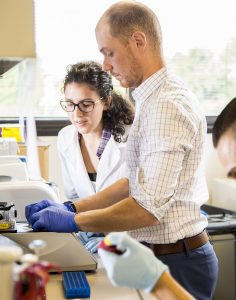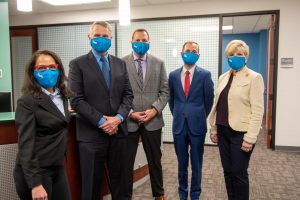Patient-screening model for OA clinical trials
Osteoarthritis is among the world’s most diagnosed diseases, affecting an estimated 7% of the global population. The Centers for Disease Control and Prevention says roughly 32.5 million American adults live with the condition, making it the nation’s leading cause of disability.
Still, no medications exist to slow or stop OA. Currently available approved drugs treat only short-term symptoms of OA and don’t target the underlying causes or long-term progression of the disease.
A major hurdle to the development of drugs to alter the underlying disease process is the difficulty of conducting effective clinical trials. Such trials typically require thousands, or even tens of thousands, of participants and take many years to complete, as the disease does not progress uniformly, rendering the assessment of investigational OA drugs extremely difficult – and expensive.

At OMRF, physician-scientist Dr. Matlock Jeffries has created a screening process to identify those patients whose OA will progress rapidly. This invention could prove a game-changer for clinical trials, drastically reducing the time, number of participants, and cost of testing new OA drugs.
Dr. Jeffries’ based his model on DNA methylation data obtained from thousands of OA patients. Users can extrapolate the data for comparison against the blood samples of prospective clinical trial participants.
“The advantage of our model is that it allows for a blood draw at a single point in time when all the patients look the same,” Dr. Jeffries said. “We can pull out which of those patients are going to show disease progression in the next two to three years, which is exactly what you want from a clinical trial perspective. I believe this model provides that level of certainty.”
If you’d like to learn more about licensing opportunities for this technology, please contact Ryan Downing.
Back home – again
 After 13 months of remote work due to the pandemic, OMRF’s Technology Ventures team returned to our onsite offices this past spring. However, we were back for just two weeks before a Friday evening flood caused extensive damage to the building we occupy. The culprit was a 6-inch, high-pressure water pipe that feeds commercial-grade air conditioning units.
After 13 months of remote work due to the pandemic, OMRF’s Technology Ventures team returned to our onsite offices this past spring. However, we were back for just two weeks before a Friday evening flood caused extensive damage to the building we occupy. The culprit was a 6-inch, high-pressure water pipe that feeds commercial-grade air conditioning units.
The damage could have been far worse. OMRF’s Comparative Medicine facility shares the building we occupy, and, fortunately, the pipe burst just before a staff member arrived for a regular check of the research animals. So, we have lab mice to thank for the flood’s early detection.
Nevertheless, the remediation and repairs sent us back to remote work for another five months. We finally returned to our offices – for good this time, we hope! – in November. Our collective return has been beneficial not only for camaraderie but also for our ability to meet more easily with those who want to stop by and see us.
And that leads me to this invitation: Please pop by for a holiday or post-holiday visit. We’d love to show you our new (old) home!
Wishing you and yours happy and healthy holidays,
Andrew Westmuckett, Ph.D.
Director, Technology Ventures
Get BioBlast delivered to your inbox — sign up here.





